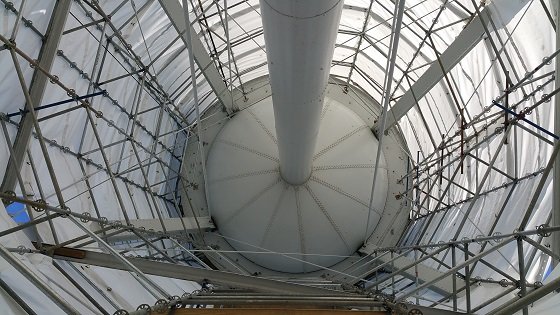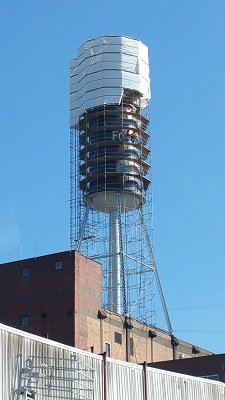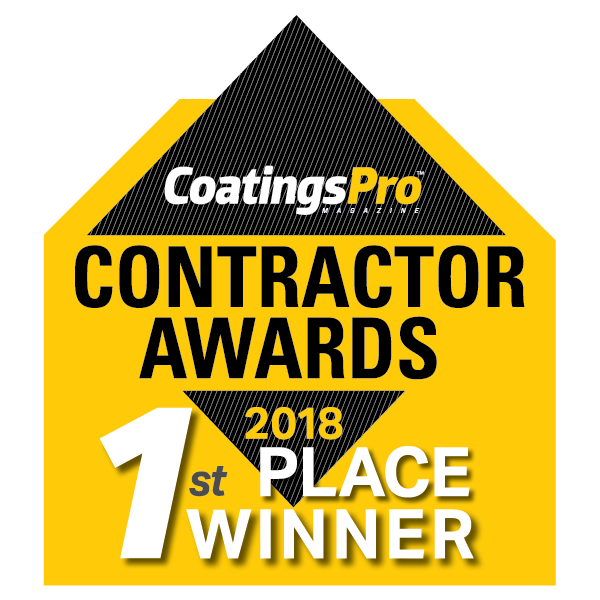AWARD RECIPIENT Humanitarian Award – 2020
Award Winner: Howell & Howell Contractors, Inc
Company Location: Louisville, KY
Description: Congratulations to Howell & Howell Contrators, Inc. for earning the Humanitarian Award! Their team donates labor, materials, equipment, supervision and management to various community efforts. Most recently, they volunteered to repaint the static displays for the Veteran's Memorial Park in Jeffersontown, KY.
Link: https://pcapainted.org/award-recipient/humanitarian-award-2020/
New Coatings Help Cardinal Stadium Take Flight
Built in 1998, Cardinal Stadium — the outdoor home of the football team at the University of Louisville (UofL) — was recently expanded to accommodate 6,000 new seats in the north end zone. The 25,000-square-foot (2,322.5 m2) expansion to both outdoor and indoor areas added new seating, as well as a five-story common area complete with restrooms, concession stands, and corporate suites.
Renovations were also made to the nearby Howard Schnellenberger Football Complex, named after the iconic UofL coach. In all, these two complexes in Kentucky took about 18 months to renovate at a cost of ~$55 million, but they couldn’t be considered complete until they were fully decked out in the school’s famous colors of cardinal red and black.
Game Plan
Fortunately, UofL already knew a local painting contractor they could trust to implement their plan. Headquartered in Louisville, Ky. — about a 20-minute drive from campus — Howell & Howell Contractors, Inc. had previously provided coatings for Cardinal Stadium as well as other university buildings such as Jim Patterson Stadium, the home field of the Cardinals’ baseball team. With a crew of between 15 and 20 members, Howell & Howell had to tackle the football project aggressively so that work could be finished before the first Cardinals home game of the 2018 season.
“We had to be done and gone by midnight on Friday [before the game],” said Mike Dudukovich, vice president of coating operations for Howell & Howell. “So there was a hard schedule with a completion date at the end of it — and yes, we were able to meet it.” To make the demanding deadline, crew members initially worked four days a week in eight-, 10-, and 12-hour shifts. And as the project progressed, they regularly worked 12-hour shifts, including on weekends.
For additional assistance, Howell & Howell brought in four painting apprentices. “We’ve used this technique successfully in the past,” explained Dudukovich. “We bring them in between 30 to 60 minutes early, and they stay 30 to 60 minutes later. That way, when a journeyman comes in, all the work pots are there, all the paint is poured out, they’ve got their brushes and rollers, so they can just pick them up, and in five minutes they’re putting on paint. The overtime paid to the apprentices was money well spent.”
Closing Off the End Zone
A few years back, UofL officials decided that the horseshoe-like configuration of Cardinal Stadium — closed off at the south end zone, as well as the east and west sides — needed to be changed. By 2018, the north end zone was closed off to add more seats and fan-friendly features such as large, open common areas for pre- and post-game socializing.
The new substrates used on the north end zone expansion included drywall, corrugated metal, concrete block, and cast-in-place concrete. Existing substrates were met at tie-in locations. As construction crews completed each area, the Howell & Howell crew moved in to supply the requisite coatings. “We’re like the tail wagging the dog — we’re always at the end,” joked Dudukovich.
In terms of surface prep, the crew initially used a pole sander to make minor spot repairs, as needed. From there, Clemco blast pots with Schmidt valves helped them achieve a surface profile of between 1.5 to 2.5 mils (38.1–50.8 microns) throughout the two complexes. This enabled the crew to meet the NACE No. 3/Society for Protective Coatings (SSPC) Surface Preparation (SP) 6/ standard for a commercial blast cleaning.
UofL supplied the crew with Benjamin Moore coatings because, according to Dudukovich, the university has a deal to use their products. Graco airless paint sprayers were used to paint larger areas, while Purdy brushes and Bestt Liebco rollers were employed for cutting in and backrolling. Each non-metal surface received three coats: a primer epoxy coat at an average of 1.5 mils (38.1 microns), an intermediate epoxy coat at 5 to 8 mils (127.0–203.2 microns), and a urethane topcoat at 2 to 3 mils (50.8–76.2 microns). Dudukovich estimated that drying times for each coat required about 24 hours.
“By allowing other trades and crafts to complete their work and move into other areas, we were able to spray apply the coatings in lieu of brushing and rolling,” Dudukovich explained. This allowed the large Howell & Howell crew to apply their coatings as efficiently as possible, all while avoiding congestion from other trades.
One of the notable additions to the expanded north end zone was what Dudukovich referred to as the “spine,” or structural steel support beam for the newly installed seats. This 60- to 65-foot-tall (18.2–19.8 m) structure was coated with a zinc epoxy urethane finish system, as were other newly built metal surfaces. Another new addition to the common areas were “clouds” of different sizes and shapes that hung suspended over an exposed ceiling that was painted flat black, which created a startling visual effect. “When the light shone down, it made the ceiling disappear, so all you saw was these white clouds floating above your head,” Dudukovich recalled.
In coating these elevated surfaces, the crew observed proper safety protocols. “Anything over 4 feet [1.2 m] had to be 100 percent tied off, with 100 percent fall protection,” Dudukovich said. The crew also wore Bullard hard hats and safety glasses, high-visibility safety vests, and 3M respirator masks with organic charcoal filters as personal protective equipment (PPE). “The whole project was completely accident free — we didn’t even put a band-aid on anybody,” he recalled. “Our people did a tremendous job in being safe.”
Working Swift-ly
As crews worked on the north end zone complex, renovations were made simultaneously to the Howard Schnellenberger Football Complex located underneath the north end zone seating area. Cardinal football players saw their weight room and conditioning center double in size, and they enjoyed additional amenities such as upgraded rehabilitation facilities and expanded theaters, where they could watch game film. Coaches and trainers received refurbished offices on the second floor of the complex.
Because construction had closed off thousands of parking spots around the stadium, the university came up with other measures, such as creating an ancillary parking lot, to ease congestion. The expansion project also temporarily displaced some personnel. “The staff on site, the coaches, and even the college president moved to their old offices across the street until this was built,” noted Dudukovich. “They moved in about a month early, so their [new] offices had to be done a month prior to the first game.” When they returned to the Schnellenberger complex, they would have noticed, among other things, that the hollow metal doors to their new offices were coated with grey-colored Benjamin Moore industrial enamel paints.
Dudukovich said that the crew was able to complete its work with “minimal invasion” of staff privacy. There was only one thing able to halt progress on the project, albeit temporarily: Taylor Swift. The pop-music superstar performed at the multi-use Cardinal Stadium in June 2018.
“We had to stop for four days, but she gave out free tickets for the workers. So they didn’t complain too much,” Dudukovich said.
Coatings Touchdown
Dudukovich had nothing but praise for the “good, pleasant atmosphere” at UofL. The feedback he received for his crew’swork was similarly positive: “The president of the university, the coaches and players, came through and they all just loved it. They couldn’t say enough about how nice it looked compared to their old facilities — it was top notch.” In fact, it was “top notch” enough to win second place in the Specialty Projects category in CoatingsPro’s 2019 Contractor Awards Program.
Dudukovich was a daily presence at both work sites and oversaw the project from its start in April 2017 to its completion in October 2018. Given the tight schedule, he was proud of his crew’s commitment to excellence. “I’d come by and tell them, it’s easy for me to come by and pick out what you’re doing, but I want to tell you you’re doing this right.”
Revamp of Kentucky Whiskey Bottle Tower Lifts Spirits
Since 1936, the home base of spirits provider Brown-Forman Corp. in Louisville, Kentucky, has become known by the iconic whiskey bottle-shaped water tower on top of its corporate offices.
At 62.5 feet (19.1 m) tall and standing 218 feet (66.4 m) in the air, the riveted carbon steel “bottle” is typically re-designed once every 10 years or so to include a new shape, cap design, and label.

Each iteration of the tower, originally used as a fire-suppression tool for Brown-Forman’s local distillery, now reflects one of Brown-Forman’s numerous prestigious brands. Those brands include Jack Daniel’s and the current Old Forester version, and the visibility attracts tourists who can see the tower from downtown.
“Everything is called Whiskey Row, said Mike Dudukovich, general manager for locally based Howell & Howell Contractors, Inc. “There are a lot of distilleries. It’s the Kentucky Bourbon Trail, and everyone always ends up at the big whiskey bottle. It’s the biggest one in the world.”
Top Shelf
Howell & Howell has become a staple on these projects over the years, with each successful job building more trust with the client for the next time.
“This is the fourth time we’ve done this bottle,” Dudukovich said. “Every time they change the label on the production bottles and the label on the tank. They want to make it look like the little bottles of whiskey you buy in the store.”
The most recent assignment — which took place in late 2016 and early 2017, prior to the Kentucky Derby horse race — included extra hurdles for the five-man crew to navigate. Rather than merely painting over the old version, the client opted for a deeper investment.
“The existing coating consisted of over 40 layers of paint, and the coating had fractured and was delaminating from the tank,” Dudukovich said. “In the past, we just overcoated it. But this time, they said ‘We’ve got the time, we’ve got the money, let’s do it right.’”
Bottled Up
To prepare for blasting off the old coatings, the tank was completely scaffolded using a system from American Scaffolding, Inc., with a 10-mil (254.0 microns) reinforced plastic wrap from Eagle Industries around the outside for containment. The crew also had to protect the existing glass atrium roof by temporarily moving numerous plant trays to a safe site, and then covering it in foam and plywood for the job.

Because this was a lead abatement project with a lead level of 89,000 ppm, the three crew members inside the containment wore Tyvek suits and pressurized Bullard blast hoods purchased from Marco as specialized personal protective equipment (PPE). Cleaning stations and a shower trailer were set up upon exiting. Meanwhile, an equipment operator on the ground stayed in radio contact with a foreman on the roof. All crew members also wore standard PPE, such as hard hats, safety glasses, gloves, and work boots. Ladders were used to access the scaffolding.
An 8-ton (7,257.5 kg) Schmidt blast pot, powered by a 1,600 cfm (45.3 m³/min.) air compressor supplied by Whayne Power Systems, was utilized for the abrasive blasting process. Over about 10 days, the crew blasted the tower’s surface to bare metal to achieve NACE No. 3/Society for Protective Coatings (SSPC) Surface Preparation (SP) 6: Commercial Blast Cleaning. A 40,000 cfm (1132.7 m³/min.) dust collector from BlastOne was utilized to pull negative air inside the containment, while HoldTight 102 was applied after blasting to prevent flash rusting.
A tunnel was erected on the roof to move spent abrasive from the containment area to trash chutes attached to the building’s side. The chutes, which included a liner to prevent dust from sticking, went to a sealed dumpster on the ground.
“Once everything was clean, we went back to the top, wiped the bottle down, then started the painting process,” Dudukovich said.
Distilling Coatings
The painting process was made slightly easier because, unlike prior jobs at the site, the crew didn’t have to deal with the intricacies of a specific logo. Instead, they simply had to prepare the tower for the eventual application of the new Old Forester logo, which would be done utilizing a graphic wrap manufactured by 3M and designed by local company Showtime Sign & Design, Inc.
“The first three times, everything was hand-lettered,” Dudukovich said. “This was the first time they elected to go with a wrap. The wrap was cheaper than having to paint it three times. It’s guaranteed not to fade for 10 years.”
The four-part coating system included the initial application of Rust-Oleum’s 9100 System DTM Epoxy Mastic as the prime coat, followed by a stripe coat along the edges, and then a third installation of the 9100 epoxy as an intermediate coat.
“The stripe coat was for all the rivets, joints, seams, and edges where the plates were riveted together,” Dudukovich explained. “This was an old, riveted tank built in 1934, so there were a lot of sharp edges.” Each coat cured overnight.
The primer and intermediate coats were spray applied using a Graco Bulldog pump system, while the stripe coat was applied on the edges using 3-inch (7.6 cm) Wooster brushes and 4-inch (10.2 cm) Bestt Liebco rollers. All coats of the 9100 epoxy went down at 5–8 mils (127.0–203.2 microns) dry film thickness (DFT).
After those three coats cured, Rust-Oleum’s 9800 System DTM Urethane Mastic was spray applied as the finish coat at 3–5 mils (76.2–127.0 microns) DFT. In all, the painting portion concluded in about two weeks.
Weather Proof
Though the Howell & Howell crew wrapped up most of the project in approximately a month, it took several more months before their work could be unveiled.

“We couldn’t put the logo on until it warmed,” Dudukovich said “The wrap had to maintain at least 50 °F [10.0 °C]. It has an adhesive on the back. They heat it, and it shrinks around all the rivet heads, all the welds and seams, and it just shrinks up real tight against everything.”
The crew also had to keep its containment device on.
“The president of Brown-Forman wanted it to be like a big flagship,” Dudukovich said. “He wanted everybody in the world to see that there’s something big going on behind this tarp, and everything had to stay hidden from the public wanting to see it. So we kept the scaffolding and the containment on through the winter, and we had to repair any holes as they appeared. Then after the winter, we had to come back and clean everything and get it ready for the wrap.”
.JPG)
“They loved it,” Dudukovich said of the client. “It’s a big deal. They closed off all the streets around the area. All the employees watched the unveiling, and the local news brought their cameras. There’s a big countdown, and we cut the ropes. As it fell down, our guys were on the back side and hidden from the public, and they pulled the ropes around the back. We’ve done it the last four times, and that’s a big reason Brown likes to have us there — we’ve never screwed up the unveiling! It’s been perfect every single time.” Even though the job came with a twist, the project was completed two weeks ahead of schedule and under the original budget price. Cheers to this coatings crew!
Weeks before the Kentucky Derby that spring, the wrap was installed. “It’s done right before the Derby because a lot of big dignitaries come in,” Dudukovich said. Per usual, the coatings crew not only succeeded with application, but also with entertainment.
Editor’s Note: Howell & Howell won 1st place in the Industrial Steel category for CoatingsPro’s 2018 Contractor Awards Program for this project. Submit your project for the 2019 Contractor Awards Program here.






